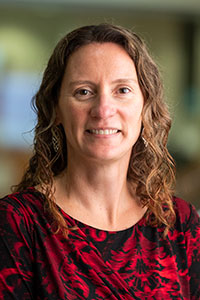Preterm birth remains a stubborn and poorly understood medical challenge, but new imaging techniques developed at the Morgridge Institute for Research are helping scientists analyze the key biomechanical features that contribute.

Researchers in the lab of Melissa Skala, a Morgridge biomedical imaging investigator and UW–Madison professor of biomedical engineering, are focusing on fetal membranes — thin tissues that surround the fetus, retain amniotic fluid and protect both the baby and mother from infection. These membranes normally break during labor, but preterm rupture is often one of the key causes of preterm birth.
Fetal membranes are too thin to be clearly detected by common imaging techniques such as ultrasound and magnetic resonance (MRI). The Skala Lab has helped fill this resolution gap with optical coherence tomography (OCT), a non-invasive technique that gathers data in three dimensions to help determine tissue structure.
Kayvan Samimi, an assistant scientist in the Skala Lab, is leading a multi-year project to image fetal membrane samples that have been provided by partner hospitals after births. Meriter Hospital in Madison and Intermountain Healthcare in Provo, Utah, collectively provided more than 60 fetal membrane samples for the study, from both vaginal and C-section births.
In the lab, Samimi developed a system to model some of the stress points these tissues would normally undergo during pregnancy, to learn about where weaknesses might lie and how a rupture might occur. The results are detailed in the June 2023 issue of the journal Biomedical Optics Express.
“These studies fill a gap in our understanding of the structural and mechanical properties of human fetal membranes at high resolution under increasing loads,” Samimi says. “This is really the first time we’ve been able to look at how these tissues respond to an active loading environment.”
The ultimate goal is to combine this data with other related projects to develop an early warning system doctors can use to assess preterm birth risk, looking at the interplay of all organs and tissues that contribute to a successful pregnancy. These include placental health, cervix stiffness, and fetal membrane integrity.
“Our first step was understanding these tissues, because they are not well studied and we need the baseline measurements,” Skala adds. “And what (Samimi) found was that the mechanical properties differ based on anatomical proximity to the lower uterus and cervix, and that the collagen matrix microstructure of the fetal membranes is responsible for these differences.”
More than one in ten pregnancies in the United States result in preterm birth, defined as occurring before 37 weeks of pregnancy. The Centers for Disease Control reports that preterm birth rates have been steadily increasing in the U.S., from 10.1 percent in 2020 to 10.5 percent in 2021. Babies born too early face higher levels of developmental and long-term health conditions, including vision, hearing and breathing problems.
“The combination of real-time OCT and mechanical testing provides new insights into deformation of the different component sub-layers of the fetal membranes, which is critical in understanding preterm failure of the complete multilayered structure.”
Michelle Oyen
While strikingly little medical progress has been made around preterm birth in the past 50 years, that may be about to change. Morgridge and UW–Madison are part of an informal research network coalescing around the problem, including scientists from Columbia University, Washington University in St. Louis and the University of Utah.
Kristin Myers, a mechanical engineer at Columbia, creates biomechanical models of pregnancy to find clues about preterm birth. Michelle Oyen, a biomedical engineer at Washington University, applies experimental and computation methods to the challenge. And Dr. Helen Feltovich, an obstetrics and gynecology physician at Intermountain Medicine in Utah, is partnering with UW–Madison medical physics professors on work related to cervical softening prior to birth.
“The combination of real-time OCT and mechanical testing provides new insights into deformation of the different component sub-layers of the fetal membranes, which is critical in understanding preterm failure of the complete multilayered structure,” Oyen says.
The national research groups continue to collaborate on various angles of the problem. Samimi says the data collected in this project will ultimately be applied to ongoing numerical modeling projects at Columbia. The collaboration has also spurred new research tracks at biomedical conferences focused on women’s health.
“It’s incredible how cooperative the uterus, cervix, and fetal membranes are in carrying the mechanical loads generated from pregnancy,” Myers adds. “It’s all a delicate balance. If the fetal membranes fail too soon in the pregnancy, the intrauterine space is more exposed, and the uterus and cervix see large mechanical loads. These large loads could lead to preterm birth. A new optical tool to tell us if the membrane is at risk for rupture will help doctors act sooner and better manage the risk.”
